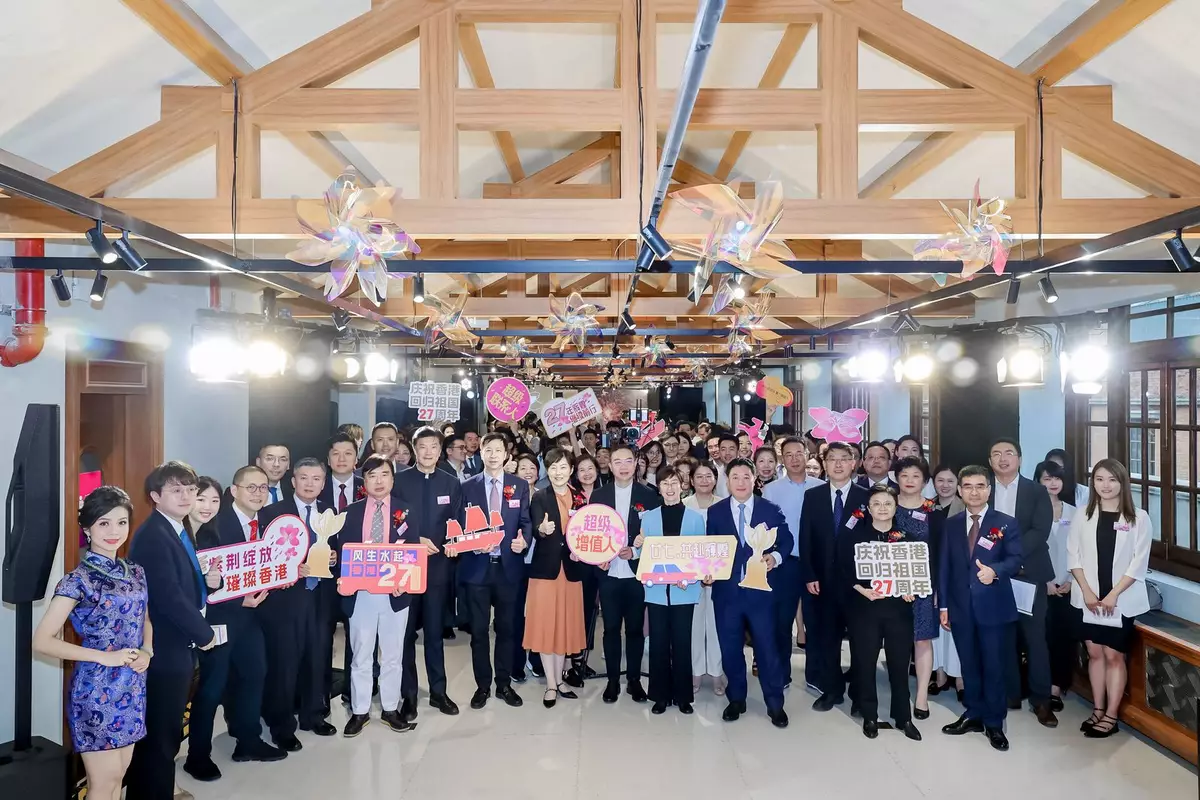Sheto celebrates 27th anniversary of hksar with diverse events in shanghai, promoting hong kong's cultural charm and travel experiences
To celebrate the 27th anniversary of the establishment of the Hong Kong Special Administrative Region (HKSAR), the Hong Kong Economic and Trade Office in Shanghai (SHETO) unveiled a series of diverse events today (July 1) in Shanghai to encourage Mainland citizens to experience the joy of Hong Kong's return to the motherland.
Click to Gallery
Sheto celebrates 27th anniversary of hksar with diverse events in shanghai, promoting hong kong's cultural charm and travel experiences
SHETO organises diversified events in Shanghai to celebrate 27th anniversary of HKSAR establishment Source: HKSAR Government Press Releases
SHETO organises diversified events in Shanghai to celebrate 27th anniversary of HKSAR establishment Source: HKSAR Government Press Releases
SHETO organises diversified events in Shanghai to celebrate 27th anniversary of HKSAR establishment Source: HKSAR Government Press Releases
SHETO organises diversified events in Shanghai to celebrate 27th anniversary of HKSAR establishment Source: HKSAR Government Press Releases
SHETO today held a reception at Zhang Yuan, a famous Shanghai-styled complex, to celebrate the 27th anniversary of Hong Kong's return to the motherland. Some 130 representatives from relevant government departments, institutions, chambers of commerce, enterprises and Hong Kong groups in Shanghai attended the reception.
Delivering a speech at the reception, the Director of SHETO, Mrs Laura Aron, said the ties between Shanghai and Hong Kong have been strong over the past years. The Sixth Plenary Session of the Hong Kong/Shanghai Co-operation Conference was held in Hong Kong in April this year, where consensus was reached on further measures in 15 co-operation areas. A total of 20 co-operation agreements were signed by government departments and relevant organisations. The successful conference marked a new milestone and created new opportunities for Shanghai-Hong Kong co-operation.
Mrs Aron thanked the Shanghai Municipal Government for its high regard for Shanghai-Hong Kong co-operation over the years, as well as for its continuous support of Hong Kong and SHETO.
The reception also featured performances by several emerging young Hong Kong artists, showcasing the charm of Hong Kong's diverse cultural offerings through performances of Cantonese opera and a string quartet.
SHETO also organised an exhibition at Zhang Yuan with the theme of "Fun in Hong Kong", promoting Hong Kong's diversity and fresh new travel experiences to visitors to implement the concept of "tourism is everywhere in Hong Kong". The exhibition featured various interactive games for the public to experience and feel Hong Kong in different forms. These included using generative artificial intelligence technology to create Hong Kong-themed characters, location identification based on sounds, simulating a tram tour of Hong Kong, and more, all designed to arouse people's interest in visiting Hong Kong and experiencing it first-hand.
The exhibition also presented a calendar of over 100 major events in Hong Kong for the second half of the year, including cultural and artistic events, sports activities, conferences and exhibitions, financial and economic initiatives, festivals and celebrations, and performances in various fields. Additionally, a dedicated area was set up to introduce Hong Kong's various talent schemes, welcoming talent and professionals from different industries and sectors to develop, work, and settle in Hong Kong.
The exhibition is open to the public from today until July 7 (Sunday) on the first floor of Building W7, Zhang Yuan, Shanghai. Admission is free.
SHETO also collaborated with the Hong Kong Tourism Board to showcase the latest tourism features of Hong Kong by dressing up two sightseeing trams in Shanghai's bustling Nanjing East Road pedestrian mall. These cars will shuttle along the street until July 31. Visitors from around the world and Mainland China can obtain the latest travel information about Hong Kong while experiencing the urban landscape of Shanghai during the ride.
SHETO will continue to hold exhibitions, cultural performances, youth activities, and economic and trade seminars in the East China region (Shanghai, Jiangsu, Zhejiang, Anhui, and Shandong provinces) to comprehensively promote Hong Kong to Mainland audiences. Members of the public can learn more details on SHETO's official WeChat account.

SHETO organises diversified events in Shanghai to celebrate 27th anniversary of HKSAR establishment Source: HKSAR Government Press Releases

SHETO organises diversified events in Shanghai to celebrate 27th anniversary of HKSAR establishment Source: HKSAR Government Press Releases

SHETO organises diversified events in Shanghai to celebrate 27th anniversary of HKSAR establishment Source: HKSAR Government Press Releases

SHETO organises diversified events in Shanghai to celebrate 27th anniversary of HKSAR establishment Source: HKSAR Government Press Releases

SHETO organises diversified events in Shanghai to celebrate 27th anniversary of HKSAR establishment Source: HKSAR Government Press Releases
Government announces next-phase tobacco control measures in response to declining smoking rates and rising health concerns
Following is a question by the Hon Edward Leung and a written reply by the Secretary for Health, Professor Lo Chung-mau, in the Legislative Council today (July 3):
Question:
The Government submitted a paper to the Panel on Health Services of this Council on the 14th of last month, outlining the Government's next-phase tobacco control measures. In this connection, will the Government inform this Council:
(1) whether it has compiled statistics on the sales of cigarettes and related tax revenues in the past three years, with a breakdown by cigarette flavour (such as original, menthol and fruit);
(2) whether it has compiled statistics on the number of persons hospitalised for diseases directly caused by smoking in the past three years, with a breakdown of the top 10 diseases by category; whether there are differences between non-smokers and smokers in terms of average inpatient days, time to recovery and medical costs for such 10 categories of disease; if so, of the details;
(3) as the Government has indicated its plan to ban flavoured cigarettes in the aforesaid paper, whether the Government has assessed the impact of this measure on smokers, such as the number of smokers switching to smoking traditional cigarettes or illegally imported flavoured cigarettes, or choosing to quit smoking as a result;
(4) as there are views that the Government should ban the addition of flavourings to waterpipe tobacco, and it is learnt that waterpipe smoking is prevalent in the Middle East, whether the authorities have assessed the impact on business travellers and tourists from the Middle East following the implementation of the relevant measure; if so, of the details; if not, the reasons for that; and
(5) of the average time required to quit smoking by persons receiving smoking cessation services provided by the Government in each of the past three years; given that the Government has indicated in the aforesaid paper that it will enhance smoking cessation services, such as increasing the number of smoking cessation service points and enhancing smoking cessation services provided by Chinese medicine practitioners, but there are views that such measures are more traditional models of smoking cessation, whether the Government will study the introduction of some newer forms of smoking cessation services?
Reply:
President,
According to the results of the Thematic Household Survey (THS) Report on smoking pattern in 2023, the proportion of persons aged 15 and above with daily smoking habit in Hong Kong has further dropped to 9.1 per cent in 2023. It also implies that there are still about 580 000 people in Hong Kong who are daily smokers of conventional cigarettes, and half of them are aged between 40 and 59. If this group of smokers continues to smoke, in the foreseeable future, their smoking-induced diseases will pose a heavy burden on the healthcare system. Last month, the Government announced the roll-out of 10 tobacco control measures in the short-term, which are formulated around four directions under the tobacco control strategy, namely, reducing the demand for and supply of tobacco products, minimising the attractiveness of tobacco products, protecting the public from the hazard of second-hand smoke and strengthening the provision of smoking cessation services, aiming to combat smoking hazard through a multi-pronged approach.
Having consulted the Hospital Authority (HA) and the Hong Kong Customs and Excise Department, the reply to the various parts of the Hon Edward Leung's question is as follows:
(1) The number of duty-paid cigarettes and duty revenue over the past five years are at Annex. Comparing the figures before and after the epidemic i.e. 2019 versus 2023, the drop in the number of duty-paid cigarettes is comparable to the decline in smoking prevalence over the same period. The Government does not maintain statistics on the breakdown of duty-paid cigarettes by flavours and related duty revenues.
The THS on smoking pattern conducted by the Census and Statistics Department reveal that about 40 per cent of current smokers of conventional cigarettes smoke flavoured cigarettes (including menthol, fruits and other flavours). Flavoured cigarettes are particularly appealing to women and young people. Currently, over 70 per cent of female smokers of conventional cigarettes smoke flavoured cigarettes; and over 60 per cent of female smokers of conventional cigarettes smoked flavoured cigarettes when they first smoked. In terms of age profile, the younger the age group, the higher the rate of smoking flavoured cigarettes. For instance, among the conventional cigarette smokers aged from 20 to 29, over 70 per cent of them currently smoke flavoured cigarettes, while nearly 70 per cent smoked flavoured cigarettes when they first smoked. As for conventional cigarette smokers in the age group of 60 or above, over 80 per cent of them smoke cigarettes of original flavour only. It can be seen that adding flavours in conventional cigarettes is an effective tactic for tobacco companies to attract the public, particularly women and young people, to smoke and continue with smoking habit. The situation is worrying.
(2) The healthcare system of Hong Kong is facing a dual challenge of increasing prevalence of chronic diseases and ageing population, while smoking is the most important and preventable risk factor leading to chronic diseases. According to the World Health Organization (WHO), smoking contributes to 16 per cent of all deaths from non-communicable diseases such as heart diseases, cancers, diabetes and lung diseases. According to the HA's data of 2019, 5 per cent of HA patients who were diagnosed with diseases such as cancers, heart diseases and emphysema account for nearly 60 per cent of HA's medical expenses, and these diseases were closely related to smoking. The Government obliged to introduce more proactive and targeted measures to lower smoking prevalence, reduce smoking and hazards of second-hand smoke, and minimise the risk of developing non-communicable diseases such as heart diseases and lung cancers among citizens, thereby enabling the public to live a healthier life and the healthcare system to concentrate the limited resources to cope with the challenges brought about by ageing population.
From the public health perspective, the additional risks and health hazards associated with smoking have been proven by a large number of empirical medical studies. Smoking significantly increases the risk of smokers for developing a wide range of chronic or serious diseases such as heart diseases, cancers, diabetes and lung diseases, which can seriously jeopardise the health of patients and would impose a heavy burden on the healthcare system. For example, the WHO has pointed out that smoking is the main cause of lung cancers and 85 per cent of lung cancer cases are related to smoking. Comparison of the medical costs for a particular disease, average inpatient days and time for recovery between smokers and non-smokers could not accurately reflect the additional public health risk brought about by smoking. Comparing the medical costs of smokers and non-smokers with the same disease and neglecting the fact that smokers are much more likely to suffer from the disease due to smoking is a common tactic used by tobacco companies to divert attention against the Government's work on tobacco control on the pretext that members of the public have the freedom of choice. Moreover, medical costs cannot fully reflect the hazards of smoking, such as the drop in productivity caused by smoking and second-hand smoke, as well as the physical and mental suffering of patients and their families, etc.
(3) and (4) In respect of reducing attractiveness of tobacco products, scientific evidence shows that flavoured cigarettes, such as menthol or fruit-flavored cigarettes, reduce the awareness of the hazard of tobacco and in turn increase the chances of non-smokers (especially teenagers) to start smoking. It also makes consumers more vulnerable to getting into and continuing with the smoking habit. The guidelines for implementation of the World Health Organization Framework Convention on Tobacco Control recommend prohibiting or restricting the use of ingredients that may increase the palatability of tobacco products. Researches from places such as Canada indicate that banning flavours in tobacco products could help encourage flavoured cigarette smokers to quit smoking and is evidently conducive to increasing their cessation rates.
The Government's proposal to ban flavours (including menthol, fruit and other flavours) in conventional tobacco products seeks to counteract the intention of tobacco companies to use flavouring agents to disguise the toxicity of tobacco products and attract women and young people to smoke.
The Government also observed that the use of flavoured waterpipes has become increasingly prevalent in recent years. A study by the Youth Quitline of the University of Hong Kong showed that the proportion of youth smokers aged 25 or below who have tried waterpipe smoking has increased from 36 per cent in 2016/18 to 45 per cent in 2020/22. The research indicates that users believe that waterpipe smoking poses lower health risks compared to regular tobacco products because of its flavours, usage patterns, and misleading marketing. Yet as a matter of fact, waterpipe smoking brings more hazards than conventional cigarettes do. The burning of waterpipe tobacco and charcoal releases a large amount of toxic substances including carcinogens and as well as harmful second-hand smoke, and even produces a large amount of carbon monoxide. The smoke inhalation from one hour of waterpipe smoking can be equivalent to 100 to 200 times that of a single cigarette, and users can be exposed to nine times the amount of carbon monoxide and 1.7 times the amount of nicotine compared to smoking a single cigarette. Repeated waterpipe smoking can also lead to nicotine dependence and may serve as a “gateway” for those who were initially non-smokers to take up the habit of smoking conventional cigarettes.
The Government's proposal to ban flavours in tobacco products will also apply to waterpipes which have been regulated as one of the conventional tobacco products. This will help prevent tobacco companies to use waterpipe smoking as another means to lure members of the public, in particular women and young people, to become addicted to smoking.
The Government has fully considered the situation of the tourism sector when formulating tobacco control measures. The choice of travel for tourists or work location for non-local talents is influenced by a variety of factors, such as overall tourism experience, development opportunities, humanistic literacies, quality of environment. Tobacco control measures will allow citizens and tourists to enjoy a fresher environment, and also make Hong Kong a healthier and more vibrant city, which will be more appealing to tourists and non-local talents and will also be welcomed by most of the general public.
(5) In terms of smoking cessation services, the current services are a combination of counselling and standard treatment with medicine (with treatment ranging from eight to 12 weeks generally), and also include self-help resources such as the Quit Smoking mobile application. Smokers who receive smoking cessation treatment are followed up by smoking cessation service providers for 52 weeks for assessment of their status of quitting. In terms of smoking cessation hotlines, clinics for smoking cessation under the HA and smoking cessation services provided by non-governmental organisations, the proportion of service users who managed to quit smoking 52 weeks after they had started quitting smoking (i.e. the percentage of service users who reported to have not been smoking in the past seven days) range from 20 per cent to 60 per cent, which are comparable to those in overseas countries. In order to strengthen services and enhance publicity and promotion, the Government proposes measures such as increasing the number of smoking cessation service points, enhancing smoking cessation services provided by Chinese medicine practitioners, providing smoking cessation services through District Health Centers under a case-management model, enhancing smoking cessation training for primary healthcare practitioners, using mobile applications to assist smoking cessation, and incorporating more elements related to smoking hazards into the regular curriculum of schools.
The Government will continue to take forward the tobacco control process incrementally so as to pave the way towards tobacco-free Hong Kong.

Source: AI-generated images
















